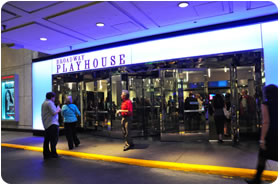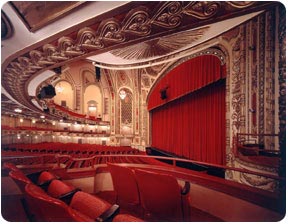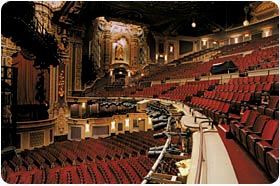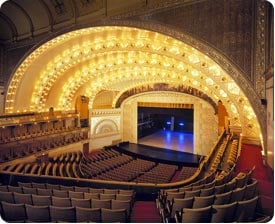

The CIBC Theatre opened as the Majestic Theatre in 1906 and was Chicago’s first million-dollar-plus venue and the city’s tallest building at the time. A hot spot on the vaudeville circuit and later host to such luminaries as Harry Houdini and Lily Langtry, the Majestic closed during the Great Depression and was shuttered for 15 years.
Much of the original design was retained when the theatre was remodeled and reopened in 1945, in time for the heyday of favorites like CAROUSEL, SOUTH PACIFIC, and GUYS AND DOLLS. The CIBC Theatre has hosted the pre-Broadway world premieres of Billy Joel and Twyla Tharp’s MOVIN’ OUT and Monty Python’s SPAMALOT, and KINKY BOOTS. Recent shows include the Chicago favorites, JERSEY BOYS, THE BOOK OF MORMON and HAMILTON.
 In April 2010, Broadway In Chicago announced a new location to their family of theaters: the Broadway Playhouse at Water Tower Place. The Broadway Playhouse went through a make-over to give the space an exciting new look, and reopened in September 2010 with a four-night inaugural engagement of AN EVENING WITH SUTTON FOSTER. The Broadway Playhouse will have its grand opening events surrounding the tour premiere of TRACES, beginning in October, followed by a newly adapted version of the musical WORKING in February 2011.
In April 2010, Broadway In Chicago announced a new location to their family of theaters: the Broadway Playhouse at Water Tower Place. The Broadway Playhouse went through a make-over to give the space an exciting new look, and reopened in September 2010 with a four-night inaugural engagement of AN EVENING WITH SUTTON FOSTER. The Broadway Playhouse will have its grand opening events surrounding the tour premiere of TRACES, beginning in October, followed by a newly adapted version of the musical WORKING in February 2011.
“This theatre will give Broadway In Chicago the ability to attract those productions that are better suited for a more intimate theatre. We hope to be able to expand the theatrical experiences we offer with this intimate and unique venue in the heart of the Magnificent Mile,” James L. Nederlander, President of the Nederlander Organization, announced.
In the 1970s, the building was originally built to house the Drury Lane Theatre and over the years went from theatre to movie theatre and back to the legitimate theatre Drury Lane Water Tower. Prior to Broadway In Chicago’s acquisition, they presented the year-and-a-half run of THE 25th ANNUAL PUTNAM COUNTY SPELLING BEE, as well as SHOUT and XANADU at the Drury Lane Theatre.
The theatre itself has undergone a complete renovation. The renovation includes a new entrance, lobby re-configuration, as well as a transformation of the interior décor that reflects a more modern look and attracts more theatrical producers interested in bringing their shows to Chicago. This venue, located in the heart of the Magnificent Mile, gives Broadway In Chicago the ability to attract productions better suited for an intimate theatre, and this intimate and unique venue has allowed the company to expand the theatrical experiences offered. Since its grand reopening, the Broadway Playhouse has hosted such hits as the tour premiere of TRACES, a newly adapted version of the musical WORKING, Nora Ephron and Delia Ephron’s international hit LOVE, LOSS AND WHAT I WORE, the critically acclaimed Broadway hit COLIN QUINN: LONG STORY SHORT and the world-wide party musical ROCK OF AGES.
 The Palace Theatre opened at the corner of Randolph and LaSalle Streets in Chicago on October 4, 1926. Designed by legendary theatre architects the Rapp Brothers, the theatre’s interior featured a splendor previously unseen in Chicago — a breathtaking vision inspired by the palaces of Fontainebleau and Versailles. The theatre’s distinctive characteristics included a lobby richly appointed in huge decorative mirrors and breche violet and white marble, which swept majestically through a succession of lobbies and foyers; great wall surfaces enhanced with gold leaf and wood decorations; and 2,500 plush, roomy seats. The theatre was originally opened as the flagship of vaudeville’s legendary Orpheum Circuit, and among the stars believed to have played the Palace in its early years are Jimmy Durante, Mae West, Jack Benny, Sophie Tucker and Bob Hope.
The Palace Theatre opened at the corner of Randolph and LaSalle Streets in Chicago on October 4, 1926. Designed by legendary theatre architects the Rapp Brothers, the theatre’s interior featured a splendor previously unseen in Chicago — a breathtaking vision inspired by the palaces of Fontainebleau and Versailles. The theatre’s distinctive characteristics included a lobby richly appointed in huge decorative mirrors and breche violet and white marble, which swept majestically through a succession of lobbies and foyers; great wall surfaces enhanced with gold leaf and wood decorations; and 2,500 plush, roomy seats. The theatre was originally opened as the flagship of vaudeville’s legendary Orpheum Circuit, and among the stars believed to have played the Palace in its early years are Jimmy Durante, Mae West, Jack Benny, Sophie Tucker and Bob Hope.
Despite the popularity of such acts, audiences in the late 1920s and early 1930s had begun to lose interest in vaudeville, and in 1931 the theatre was converted into a movie palace, initially presenting films with live stage shows, and then eventually showing only movies. When movie audiences began staying at home to watch television in the 1950s, the theatre managers, hoping to attract larger audiences, booked occasional Broadway shows into the theatre, such as GENTLEMAN PREFER BLONDES starring Carol Channing.
During the late 1950s, the Palace was fitted with special equipment to show films in Cinerama. During the mid-1970s, the management of the Bismarck Hotel transformed the auditorium into a banquet hall by removing the seats on the orchestra level and bringing the floor flush with the stage. In 1984, the theatre, now renamed the Bismarck Theatre, was converted into a rock venue. Sporadically used during the 1990s, the venue was completely restored and renovated during 1999, and reopened as the Cadillac Palace Theatre in the fall with the premiere of Elton John and Tim Rice’s AIDA.
Since then, the Cadillac Palace has been the home to several pre-Broadway hits including THE PRODUCERS – THE NEW MEL BROOKS MUSICAL and MAMMA MIA! as well as long-run engagements of Disney’S THE LION KING and Oprah Winfrey presents THE COLOR PURPLE.
 As one of the first motion picture palaces whose décor was inspired by the Far East, Chicago’s Oriental Theatre opened to much fanfare on May 8, 1926. Designed by George L. and Cornelius W. Rapp for theatre managers Balaban and Katz, the theatre, a virtual museum of Asian art, presented popular first-run motion pictures, complemented by lavish stage shows. Turbaned ushers led patrons from the lobby, with polychrome figures and large mosaics of an Indian prince and princess, through an inner foyer with elephant-throne chairs and multicolored glazed Buddhas, to the auditorium’s “hasheesh-dream décor.”
As one of the first motion picture palaces whose décor was inspired by the Far East, Chicago’s Oriental Theatre opened to much fanfare on May 8, 1926. Designed by George L. and Cornelius W. Rapp for theatre managers Balaban and Katz, the theatre, a virtual museum of Asian art, presented popular first-run motion pictures, complemented by lavish stage shows. Turbaned ushers led patrons from the lobby, with polychrome figures and large mosaics of an Indian prince and princess, through an inner foyer with elephant-throne chairs and multicolored glazed Buddhas, to the auditorium’s “hasheesh-dream décor.”
Among the many stars that played the theatre are Paul Ash (billed as “the Rajah
of Jazz”), The Three Stooges, Judy Garland, Al Jolson, Stepin Fetchit, Sophie Tucker,
George Burns and Gracie Allen, Cab Calloway, Duke Ellington, Fanny Brice, Danny
Kaye and Alice Faye. During a record-breaking week in 1930, as many as 124,985
patrons visited the Oriental to see the hit film “Flight.” Although management
changed hands several times in the subsequent decades, the theatre continued to
feature films until the early 1970s, at which time it hosted live performances by
such artists as Stevie Wonder, Gladys Knight and the Pips and Little Richard.
Soon the theater fell into disrepair. In an effort to preserve the theatre, it was added
to the Federal National Registry of Historic Places in 1978, but the building continued
to crumble. The theatre was closed to the public in 1981, and the site was considered
for a two-story, 50,000 square-foot shopping mall and a 1,600 seat cinema. In 1996,
Chicago Mayor Richard M. Daley announced that the venue would be restored to
its original grandeur for the presentation of live stage musicals. Renamed the Ford
Center for the Performing Arts in 1997, the restoration of the theatre was completed
in October 1998, at which time it was opened with the Chicago premiere of RAGTIME.
In 1999, FOSSE debuted at the Oriental Theatre before embarking on a national tour.
The list of hits goes on, including the pre-Broadway premiere of BLAST in 2000, the
world premiere of SING-A-LONG WIZARD OF OZ in January 2003, the record-breaking
run of WICKED from 2005 to 2009, BILLY ELLIOT and the pre-Broadway World
Premiere of BIG FISH in 2013. In 2014, the hits include the National Tour Premiere of
MOTOWN and Disney’s NEWSIES. In summer 2015, the pre-Broadway of ON YOUR FEET! THE STORY OF EMILIO & GLORIA ESTEFAN made its debut, followed by the
Pre-Broadway World Premiere of THE SPONGEBOB MUSICAL (Summer 2016). The theatre continues to host a record number of Pre-Broadways including ESCAPE TO MARGARITAVILLE (Fall 2017), PRETTY WOMAN THE MUSICAL (Spring 2018), and THE CHER SHOW (Summer 2018).
In February 2019, the theatre will be renamed the James M. Nederlander Theatre in honor of James M. Nederlander, the legendary Broadway theatre owner and producer, patriarch of Broadway and champion of Chicago’s Downtown Theatre District. As founder of Broadway In Chicago, it is appropriate for the name James M. Nederlander to grace the marquee of Chicago’s iconic theatre.

 In the same spirit in which the City of Chicago created the theatre district, Broadway In Chicago and Auditorium Theatre join forces to light up the Auditorium Theatre. Broadway In Chicago reaches out to form an unprecedented partnership between not-for-profit and for-profit. The two organizations have formed a long-term alliance that allows Broadway In Chicago the theatrical rights to book the prestigious Auditorium Theatre.
In the same spirit in which the City of Chicago created the theatre district, Broadway In Chicago and Auditorium Theatre join forces to light up the Auditorium Theatre. Broadway In Chicago reaches out to form an unprecedented partnership between not-for-profit and for-profit. The two organizations have formed a long-term alliance that allows Broadway In Chicago the theatrical rights to book the prestigious Auditorium Theatre.
Opened in 1889 by famous architects Louis Sullivan and Dankmar Adler, the Auditorium’s architectural ingenuity, perfect acoustics, technical versatility and sightlines became internationally revered. The Auditorium building was the first multi-purpose building incorporating a hotel, offices and retail spaces along with the theatre, and one of the first public buildings to use newly developed modern technologies of its time: electric lighting and air-conditioning. There are hundreds of Sullivan’s intricate stencil patterns, ornate gilded and bas-relief designs and endless floor and wall mosaics. Radiant 24-karat gold-leafed ceiling arches and exquisite murals adorn the house of the theatre. Frank Lloyd Wright, who received much inspiration working his first job as a draftsman on the project said the Auditorium is, “The greatest room for music and opera in the world-bar none.”
Broadway In Chicago’s loyal season ticket holders and group clients will share the new programming at the Auditorium Theatre. Broadway In Chicago will continue to actively work on bringing the newest and the best of Broadway to Chicago. The Auditorium and its newly formed board will also be actively presenting the finest cultural and community programming in Chicago at the Historic Auditorium Theatre.
The Auditorium Theatre, an independent not-for-profit organization, is committed to presenting the finest in international, cultural and community programming in Chicago, and to the continued restoration and preservation of the Historic National Landmark Theatre.






